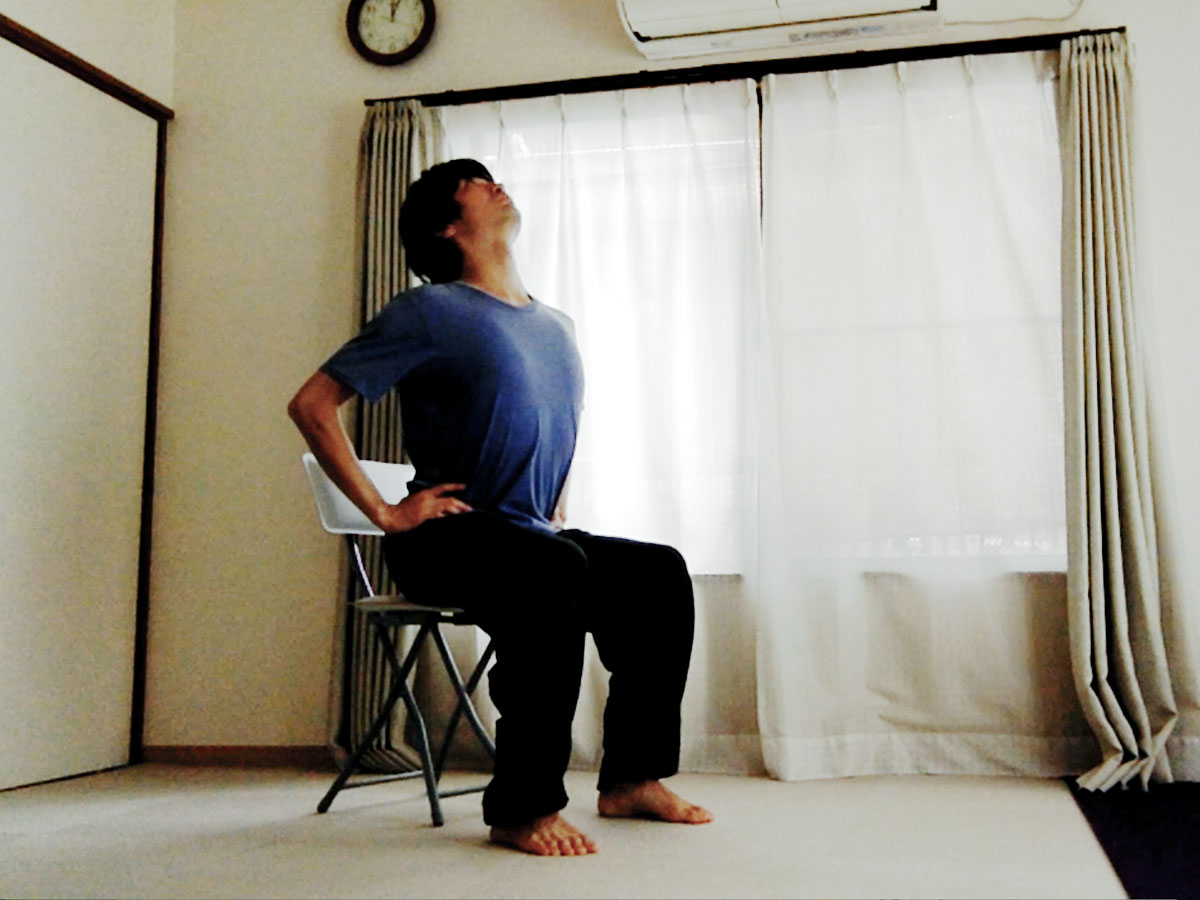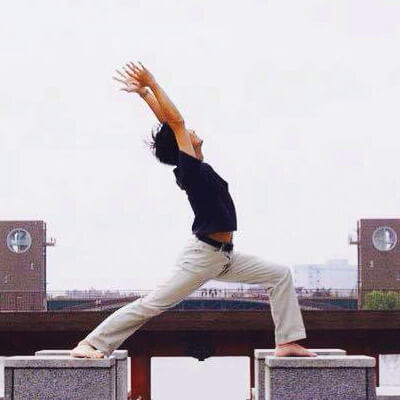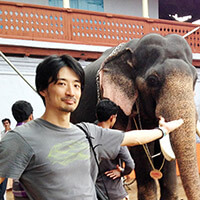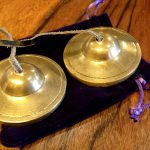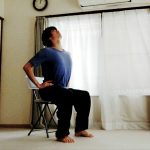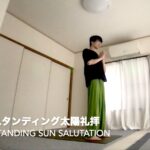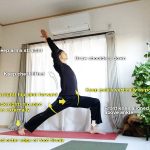Introducing the sequence of chair yoga for beginners, which is done in my regular office yoga lessons.
There is no need for yoga mats or changing clothes.
Contents of this article
Attitude and breathing
Keep breathing deeply while the practices.
Try to be as relaxed as possible so as not to force yourself.
You don’t have to do all of the exercises bellow. Avoid painful or uncomfortable movements.
It’s good that you finish following practices with a few minutes of meditation or the relaxing pose.
Relaxing pose
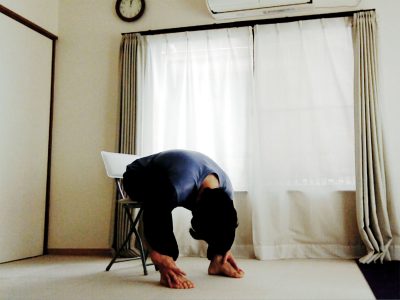
This pose is important to switch your mind and body.
It’s good for you to concentrate on the following exercises. So, try to relax with this pose and forget about study or work.
Loosen your whole body and curl down your back. Your arms should hang loosely between the legs, and if possible, pass the arms under the knees and lightly hold the ankles.
Feet / Ankles
Toes Goo-Choki-Choki-Par
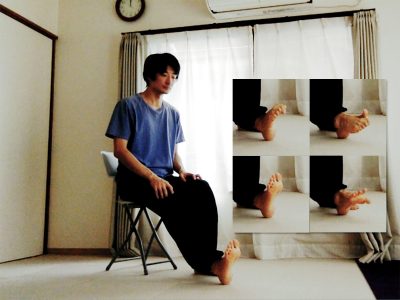
Move your toes firmly. Goo: bend all toes deeply. Choki: pull the thumb toward you and push the thumb toward the sole of the foot. Par: stretch and spread all toes.
Do it about 5 sets.
Ankle bend and stretch / Ankle rotation

Bend and stretch your ankles deeply.
Try to expand the range of motion little by little.
If you have trouble moving, massaging the area around your ankles and calves by hand is helpful.
Bend and stretch the left and right ankles about 5 times each, and rotate them 5 times towards the each direction.
Knee / Hip joint
Knee bend and stretch

Keep your back as straight as possible and bend and stretch your legs. Support your hands by lightly touching the back of your knees.
When you extend your knees, you extend your ankles, and when you bend your knees, you also bend your ankles. Stretch your knees when you inhale and bend your knees when you exhale.
Do it about 5 times on each side.
One-legged forward bend
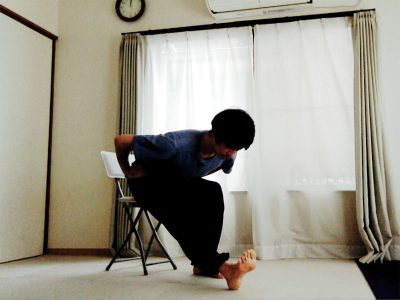
Sit shallowly on a chair, stretch one leg, press the heel against the floor, and lift your toes.
While stretching your back so that you don’t get too stooped, bend forward so that your abdomen is closer to your thighs.
Take about 5 breaths on each side.
One-legged butterfly (hip external rotation)
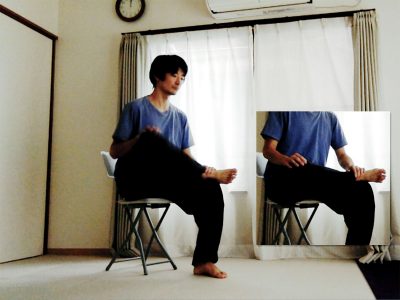
With your ankles bent 90 degrees as much as possible, place your foot on your thigh (not too close, just above your knees), and rotate your hip to rock your knees up and down.
Do it about 10 times on each side.
Swan’s leg (hip external rotation + forward bend)

With the above pose, keep your knees at the lower position and bend forward to bring your chest closer to the shin.
Take about 5 breaths on each side.
Reference: Swan Pose (Yin Yoga)
Garuda’s leg (internal rotation of the hip joint)
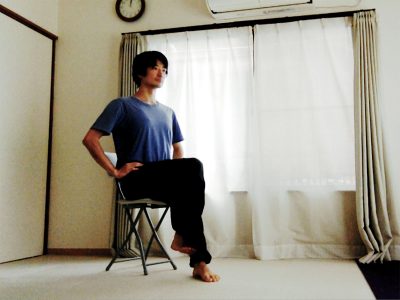
With the left and right ischium evenly grounded to the chair, cross your right thigh over your left, hook the top of your foot behind your left calf.
Take about 5 breaths on each side.
Open leg stretch
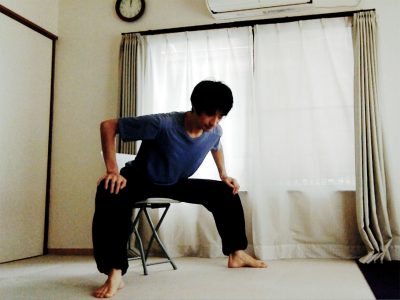
Place your hands on your knees and open your legs as wide as possible. Make sure your knees and toes point in the same direction.
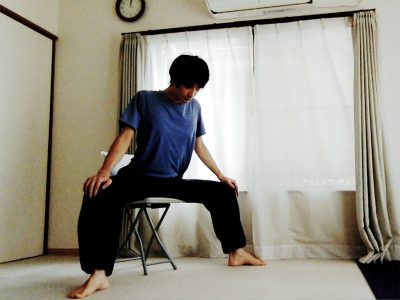
If possible, keep your arms straighten.
Keep about 10 breaths.
Front thigh stretch

Only this and the next exercise are difficult to do while sitting on the chair, so do them while standing.
If it is difficult to keep balancing, you can put your hand on the chair.
Bend the knee of one leg, hold the instep with your hand, and stretch the front side of the thigh muscle by pulling the heel toward the buttocks. Keep your pelvis facing forward and your knee of bent leg pointing straight down as much as possible.
Take about 5 breaths to the left and right.
Reference: Virasana
Reference: Bhekasana
Ardha Natarajasana (hip extension)
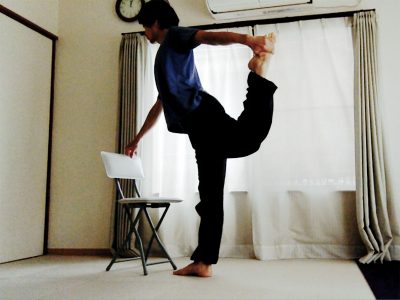
Stretch the anterior side of the hip joint with the knee behind the pelvis.
Try to keep your heel of raised leg away from your buttocks and pull your hand with your foot.
Take about 5 breaths on each side.
Spine / Pelvis
Cat and cow (increases spine flexibility)
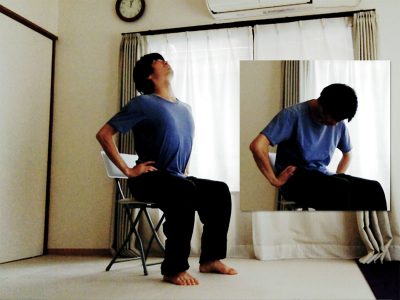
Try to move the entire spine and the pelvis. For warping movement, first tilt the pelvis forward, and for rolling movement, tilt the pelvis backwards.
Inhale in warping movement and exhale in rolling movement.
Do it about 5 sets.
Lateral bend

Raise your arms along your ears, stretch your body, and bend sideways. Keep both side of the buttocks on the ground.
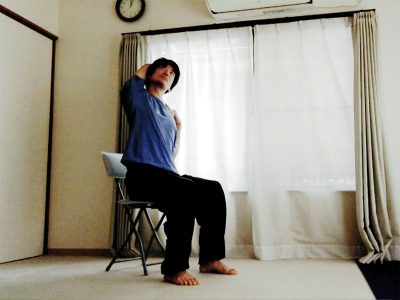
There are also variations such as bending sideways with holding the elbow behind the head.
Take about 5 breaths on each side.
Backbend
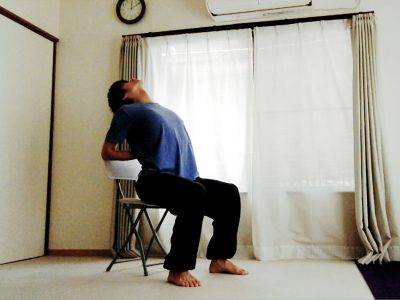
Sit shallowly on a chair and support your lower back with your hands. Bend your chest back so that your pelvis does not tilt backwards.
Stretch your entire spine and bend it so that your lower back is not overloaded.
When it is completely warped, keep it for about 5 breaths, then carefully stack the spine and return to the upright position.
Ardha Matsyendrasana (Twist)

Twist the spine with the left and right buttocks evenly on the ground.
If possible, use costal breathing to twist your abdomen while stretching your spine. Keep breathing deeply.
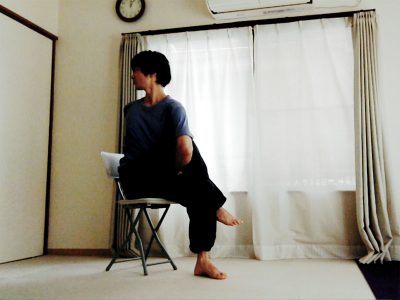
Once you get used to it, there are variations such as passing your arm under your knee and holding your hands on your back.
Take about 10 breaths each.
Reference: Ardha Matsyendrasana
Hands / Arms / Shoulders
Hands clenching and unclenching
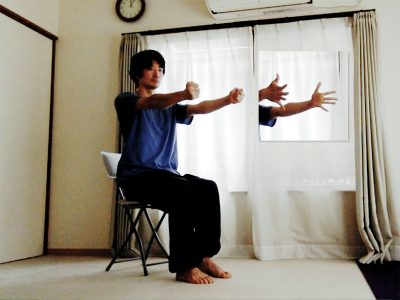
Repeat the movement of clenching your hand firmly (with putting your thumb inside) and unclenching your hand.
Do it about 8 sets.
Wrists bend and stretch / Wrist rotation

Extend your wrist with your palm facing down, then bend it up and down 90 degrees repeatedly.
Do it about 8 sets.
Then put your thumb inside, clench your hands, and rotate your wrist.
Rotate left and right about 8 times each.
Shoulder rotation
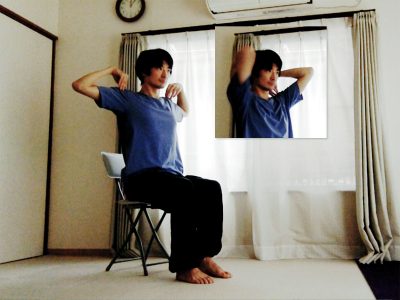
Place your hands on your shoulders and rotate them in a circular motion with your elbows.
Do it about 8 times each.
Armpits stretch and spine twist
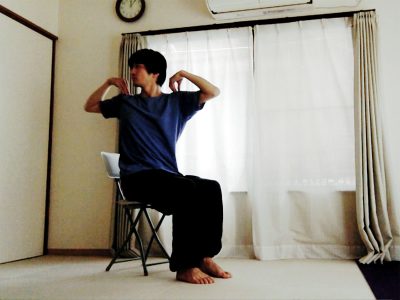
Place your hands on your shoulders and twist your spine, keeping your elbows and shoulders at the same height. Without stopping, repeat the twisting movement smoothly.
Do it about 8 sets.
Gomukha’s arm (shoulder extention, internal rotation of the upper arm)
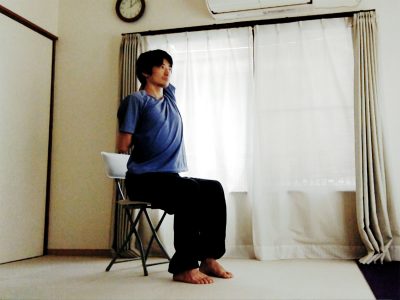
Turn one arm from above and the other from below to your back and hold your hands on your back.
Keep about 5 breaths on each side.
Garuda’s arm (shoulder flection, external rotation of the upper arm)
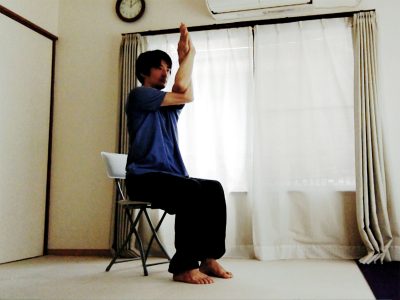
Bend the elbow of one arm and put the forearm in front of the body, entangle the other from below, rotate the upper arms outward and cross the arms, and put the palms together.
Keep about 5 breaths on each side.
Putting elbows together (shoulder flection / internal rotation of the upper arm)
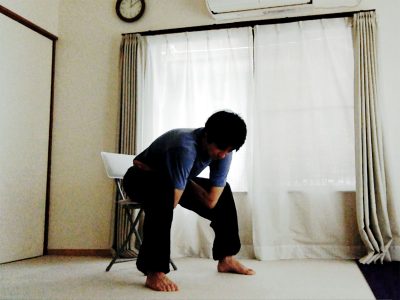
Place the back of your hand on both sides of your waist (so that your wrists are not close to each other), and rotate your upper arm inward to bring your elbows closer. Do not shrug your shoulders.
You can use your legs to support to make your elbows closer.
Keep about 10 breaths.
Hirahira stretch (upper arm rotation, chest opening)
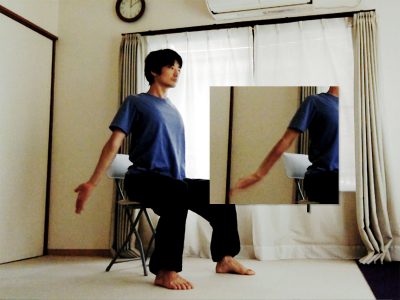
Extend your arm backward and twist it in and out so that it rotates firmly not only from your wrist but also from your upper arm.
Do it about 8 sets.
Neck / Face / Head
Neck rotation
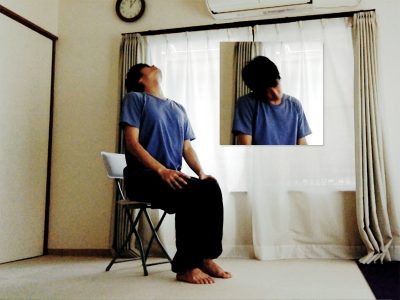
Rotate your neck to draw the circle as bigger as possible.
Turn left and right about 5 times each.
Neck stretch with hands
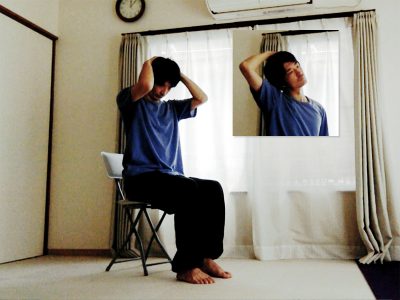
Bend the neck at a comfortable angle, and while keeping it in that position, the hands try to tilt further and the neck moves to return straight and push each other. After keeping it for about 3 seconds, loosen it suddenly.
Do it at a comfortable angle.
Ear pull
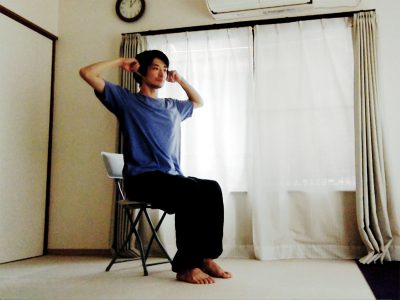
Rotate your ears while pulling them lightly. Loosen the muscles of the scalp and the “sphenoid bone” in the middle of the head. It is also effective for dizziness and headaches.
Slowly rotate it about 8 times each.
Scalp tapping

Use your fingertips to lightly tap the scalp to promote blood circulation. Recommended in the morning or when your head does not work.
Do it for about 30 seconds within a comfortable range.
Eye stretch 1
Do not move the neck, keep the eyeballs in 8 directions for 10 seconds each, and stretch the extraocular muscles (muscles that move the eyeballs).
Alternately go in the opposite direction from “top to bottom” to “right to left” to “top right to bottom left” to “top left to bottom right”.
Eye stretch 2
Place your finger in front of you and focus on your fingertips.
Slowly move your finger in a figure “∞” and “8”, and the eyeball will follow while focusing on your fingertips. Gradually move it farther or closer, and try changing the distance.
This stretches the ciliary muscle (the muscle that focuses).
Breathing methods
Abdominal breathing
It is a breathing method when you want to rest your head and body.
Sit in a relaxed posture, place your hand on “Tanden”, which is about two or three fingers below your navel, and inflate your stomach when you inhale, and dent your stomach when you exhale, and take a deep breath.
Take 1 to 2 minutes with a long breath (ex. inhale 5 seconds and exhale 10 seconds).
Costal breathing
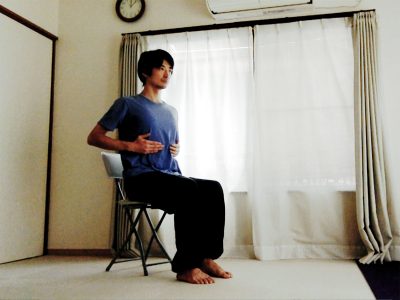
It is a breathing method when you want to activate your head and body.
Place your hand near the bottom of your ribs and keep your abdomen tight, taking a deep breath, as if you inflate your ribs when you inhale and deflate your ribs when you exhale.
Take 1 to 2 minutes with a long breath (ex. inhale 5 seconds and exhale 10 seconds).
Full yogic breathing
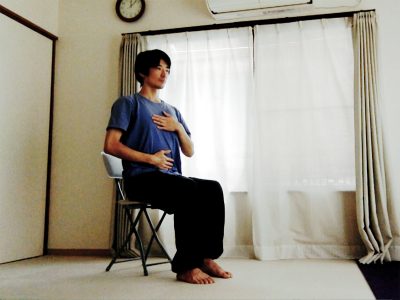
It is a breathing method that combines abdominal and costal breathing. Exhale from the entire upper body first, then inhale in order from the bottom of the abdomen to the upper part of the chest, then exhale in order from the upper part of the chest to the bottom of the abdomen so that you can exhale completely.
Take 1 to 2 minutes with a long breath (ex. inhale 10 seconds and exhale 10 seconds).
Alternate nostril breathing
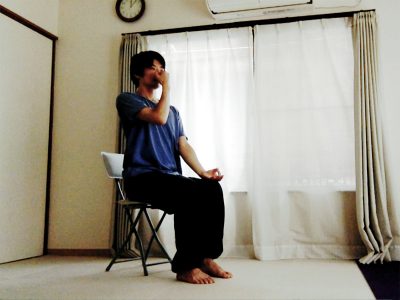
It is a breathing method that uses your fingers to close one nose and then inhales and exhales through alternate nostrils. It balances the left and right sides of the body, adjusts the autonomic nerves, and enables smooth switching between the mind and body.
The basic flow is to inhale 4 seconds from the left → exhale 8 seconds from the right → inhale 4 seconds from the right → exhale 8 seconds from the left.
Take about 5 sets with deep breathing.
Meditation

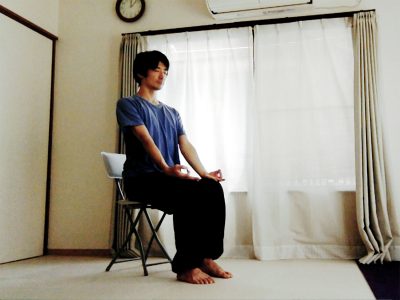
It is important that your spine is upright and your whole body and mind is relaxed. Keep your eyes closed or half-eyed. Hands are placed in comfortable position.
There are various meditations, but first practice focusing on your breathing. Focus on taking a deep breath, inhaling for 5 seconds and exhaling for 10 seconds.
If you think about other things, try to return to concentration again.
Tips for making it a habit
Do not ask for results, but try to do it within a comfortable range.
It’s a waste of time and energy to fight the confusion of “what should I do, what should I do …”. Get rid of your thoughts right away, and if you decide to do it, put it into practice. It ‘s good to decide the time, and I think it’s good to decide to do it once a day.
However, it is common for such confusion to arise. It is also an important experience to repeat “cleaning up and concentrating” , and by repeating it, the speed of throwing away the thoughts will surely increase .
The more you do, the more changes are happening in your mind and body, so let’s pay attention to the small changes and continue enjoying the practices.

